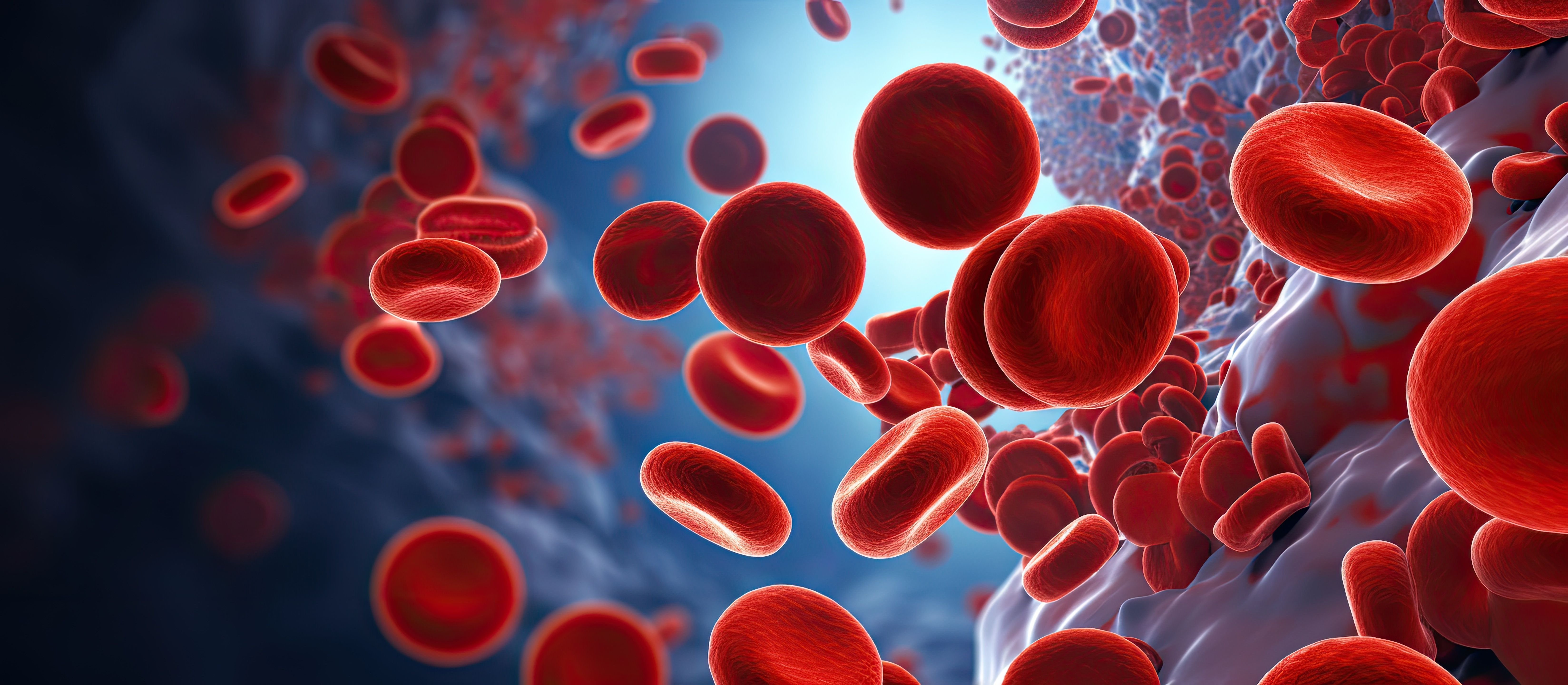Ruxolitinib/Belumosudil Combo Leads to 55% Response Rate in GVHD
The ruxolitinib and belumosudil combination demonstrated a 55% overall response rate in GVHD, suggesting synergy between inflammatory pathways. The combination was well-tolerated, delayed the need for other therapies.
Microscopic images of red blood cells activated platelets and white blood cells are showcased in the photographs as a result of leukemia: © AkuAku - stock.adobe.com

The combination of ruxolitinib (Jakafi) and belumosudil (Rezurock) showed a 55% overall response rate (ORR) in a small, single center retrospective analysis that included 20 patients with graft-versus-host disease (GVHD). The findings of the retrospective analysis were presented at the 2024 Tandem Meetings on Transplantation & Cellular Therapy.1
“Response was observed with the combination despite progression on both agents as monotherapy, which may suggest synergistic effects in targeting different inflammatory pathways. The combination is tolerable, delays the need for alternative therapies, and facilitates the tapering of corticosteroids,” investigators wrote in the poster.
The ORR, which included complete responses (CR) (n=1, 5%) and partial responses (PR) (n=7, 35%), was 55% in 11 of the 20 patients at any time during the analysis (95% CI, 0.32 - 0.77). However, 1 patient was excluded due to insufficient treatment time. There were 3 patients (15%) who experienced PR and then progression, 6 patients who had no response (30%), 2 patients progressed (10%) and 1 patient who experienced a mixed response (5%).
The median time to response was 91 days, the duration of response was 48 days, and the median time to progression after a response was 28 days. Among the 3 patients who did not respond to ruxolitinib or belumosudil monotherapy, the combination therapy led to1 patient showing a CR and 2 patients showing a PR. There were 5 patients (25%) who discontinued treatment after a median of 125 days and all other immunosuppressive agents were either tapered or discontinued in all patients that had a response to the combination.
According to response by organ system, there were 7 organ types addressed: upper gastrointestinal (10% of patients had CR), liver (15% of patients had CR), lung (5% had CR, 15% each had either PR or progression), musculoskeletal (5% each had either PR or progression), ocular (5% each had either CR, PR, or progression), oral (10% each had either CR or progression and 15% had PR), skin (5% each had either CR or PR).
Patients included in the analysis had previously undergone allogeneic hematopoietic cell transplantation, developed GVHD, and received the ruxolitinib and belumosudil combination between February 1, 2022, and August 30, 2023. Eligible patients could have any disease or transplant type and the effects of the combination therapy were monitored for up to 12 months from initiation.
The majority of patients were female (60%) with either had myeloablative (65%) or reduced intensity (35%) conditioning regimens. Patients received either tacrolimus (Prograf) and methotrexate (MTX) (90%) or tacrolimus, MTX, and anti-thymocyte globulin (10%). The graft source received was either peripheral blood (95%) or bone marrow (5%) and the donor type was either matched but unrelated (75%) or related to the patient (25%).
The overall chronic GVHD (cGVHD) grade at diagnosis was either mild (45%), moderate (40%), or severe (15%), and the cGVHD at the onset of the combination was also mild (10%), moderate (25%), or severe (65%). For the best response cGVHD grade 10% of patients had mild best response, 30% had moderate, 55% had severe, and 5% had CR.
Regarding adverse events (AEs), there were no patients who had or developed cytomegalovirus, Epstein-Barr virus, graft failure, or relapse disease, and there was no worsening of cytopenia.
However, 4 patients (20%) developed pneumonia and 2 developed (10%) an upper respiratory infection. Belumosudil was decreased in 1 patient because of AEs not mentioned in the poster but then tolerated at the decreased dose, and 1 patient died while receiving the combination therapy.
Historically, ruxolitinib and belumosudil monotherapy has an ORR of 76%and 65%, respectively.2,3 Other commonly used treatments have a lower response rate of 26%, as shown in the REACH3 study (NCT03112603).4 Both ruxolitinib and belumosudil are well-tolerated medications with different primary targets: ruxolitinib targets the JAK/Stat pathway, whereas belumosudil targets ROCK2.2
“Possible synergistic effects of combination therapy, targeting GVHD from multiple inflammatory pathways may yield higher response rates [and] possible underlying changes in the pathophysiology and manifestations of chronic GVHD over time, [which] could support re-introducing previously failed therapies for use in combination with other agents,” investigators hypothesized.
Moving forward, “large scale studies [are] warranted to evaluate the efficacy, safety, and durability of response to combination therapy, though there may be overlapping downstream effects of STAT3 and STAT5,” they noted.
References
1. Caputo J, Peddireddi A, Bhatta S, et al. Combination ruxolitinib and belumosudil is tolerable and induces responses despite treatment failure as monotherapies. Presented at: 2024 Transplantation and Cellular Therapies Meeting; February 21 to 24, 2024; San Antonio, TX. Abstract 382.
2. Cutler C, Lee SJ, Arai S, et al. Belumosudil for chronic graft-versus-host disease after 2 or more prior lines of therapy: the ROCKstarstudy. Blood. 2021;138(22):2278-2289. doi:10.1182/blood.2021012021
3. Zeiser R, Polverelli N, Ram R, et al. Ruxolitinib for glucocorticoid-refractory chronic graft versus-host disease. N Engl J Med. 2021;385(3):228-238. doi:10.1056/NEJMoa2033122
4. Zeiser R, Polverelli N, Ram R, et al. Ruxolitinib for glucocorticoid-refractory chronic graft-versus-host disease. N Engl J Med. 2021;385(3):228-238. doi:10.1056/NEJMoa2033122
PTCy Offers New Hope for Mismatched Stem Cell Transplants in Leukemia, MDS
April 13th 2024Jeff Auletta, MD, discussed how PTCy-based graft-vs-host disease prophylaxis offers a promising approach for expanding access to successful cell transplantation regardless of donor match or patient ethnicity.
Read More